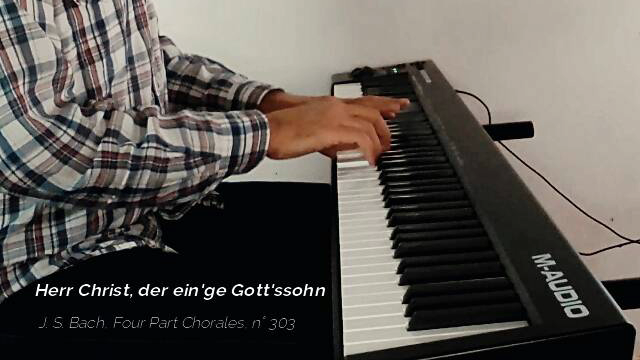Musical Reading || Herr Christ, der ein'ge Gott'ssohn, Chorale #303
Hello all music lovers! Today I want to start this series titled “Musical Reading”, in which I will share one or two musical works for keyboard (piano, organ or harpsichord) weekly in order to exercise myself and continue perfecting the art of sight reading. I am going to start with a short work by the German composer J. S Bach, it is the Four-Part Chorale No. 303, entitled “Herr Christ, der ein'ge Gott'ssohn”.
I hope you will join me in this exciting journey that I don't know where it will take us, I just hope that we discover and enjoy a lot of music together.

But before talking a little more about the work, I want to tell you why I want to start this series. Last year was a difficult year personally, I suffered inflammation of the sciatic nerve that affected me greatly, I could not stand for long nor could I sit for more than a few minutes... This affected my relationship with my musical instrument, not only my practices decreased considerably, so did my spirit and my strength. It took about 10 months of fighting until the pain finally went away.
I begin this series as an exercise in personal motivation and at the same time as a celebration for being able to sit for several hours playing the piano without having to suffer any discomfort or pain. For this I thank God.
Now, returning to the piece that I am performing today, I want to talk a little about this work and the Chorales in general. The structure of this composition is like an intricate tapestry of intertwined voices. Bach employs his unique ability to weave melodic lines that intertwine and complement each other, creating a dense and exciting musical texture. Each of the four parts (soprano, alto, tenor and bass) has its own personality, but together they form a coherent and expressive whole.
The chorale itself, often based on hymns or religious songs, carries with it a deep meaning. Bach's music, in general, had a strong connection with his Lutheran faith, and this piece is no exception. The richness of the harmony and the evolution of the melodic lines can be interpreted as an expression of the composer's spirituality.
I don't want to say goodbye without first thanking you for reading this publication to the end and inviting you to continue following my publications.
In this link you can enjoy my previous presentation
Peace and good!
Spanish Version
¡Hola a todos los amantes de la música! Hoy quiero iniciar este serial titulado “Lectura Musical”, en el que compartiré semanalmente una o dos obras musicales para teclado (piano, órgano o clavecín) con el objeto de ejercitarme y seguir perfeccionando el arte de la lectura a primera vista. Voy a comenzar con una obra breve del compositor alemán J. S Bach, se trata del Coral a Cuatro Partes n° 303, titulado “Herr Christ, der ein'ge Gott'ssohn”.
Espero quieran sumergirse conmigo en este emocionante viaje que no sé a dónde nos llevará, sólo espero que descubramos y disfrutemos juntos de mucha música.
Pero antes de hablar un poco más de la obra, quiero contarles por qué quiero iniciar este serial. El año pasado fue en lo personal un año difícil, sufrí una inflamación del nervio ciático que me afectó mucho, no podía estar de pie mucho tiempo ni podía permanecer más de unos minutos sentado… Esto afecto la relación con mi instrumento musical, no sólo mis prácticas disminuyeron considerablemente, también mi ánimo y mis fuerzas. Transcurrieron cerca de 10 meses de lucha hasta que finalmente el dolor se fue.
Inicio este serial como un ejercicio de motivación personal y a la vez como una celebración por poder ya sentarme varias horas a tocar el piano sin tener que sufrir alguna molestia o dolor. Por ello doy gracias a Dios.
Ahora, volviendo a la pieza que hoy interpreto, quiero hablar un poco de esta obra y de los Chorales en general. La estructura de esta composición es como un tapiz intricado de voces entrelazadas. Bach emplea su habilidad única para tejer líneas melódicas que se entrelazan y se complementan, creando una textura musical densa y emocionante. Cada una de las cuatro partes (soprano, alto, tenor y bajo) tiene su propia personalidad, pero juntas forman un todo coherente y expresivo.
El coral en sí mismo, a menudo basado en himnos o cantos religiosos, lleva consigo un significado profundo. La música de Bach, en general, tenía una fuerte conexión con su fe luterana, y esta pieza no es una excepción. La riqueza de la armonía y la evolución de las líneas melódicas pueden interpretarse como una expresión de la espiritualidad del compositor.
No me quiero despedir sin antes agradecerte por leer hasta el final esta publicación e invitarte a seguir pendiente de mis publicaciones.
En este enlace puedes disfrutar de mi presentación anterior
¡Paz y bien!
▶️ 3Speak
You and I are each thinking about Bach and his chorales, and are thanking God for coming through a struggle ... I have been listening to "Nun komm, der Heiden Heiland" and am now just discovering this one ... THANK YOU!
Thanks for comment! What a nice coincidence. Greetings and blessings!
Greetings and blessings also to you!
You play so beautiful! I enjoy it. Thank God for your life. Don't give up on this challenge you have set down for yourself. You will definitely get back your former musical strength and be better than before with daily practicing. I wish you the best of luck.
Thank you! Amen!
Hola amigo lo que puedo rescartar con tu post es que "la musica no es inocente" y tiene el poder la sanación por excelencia, nos impulsa a expresar lo más oculto de nuestra humanidad, felicitaciones por esa sanación, y con el amor de Dios sigas compartiendo tanta belleza musical.